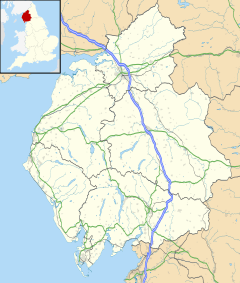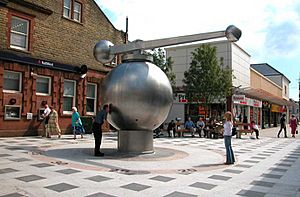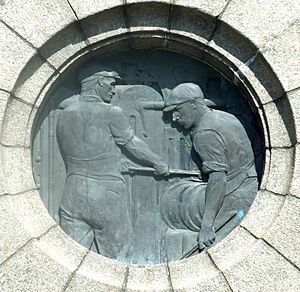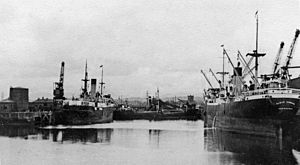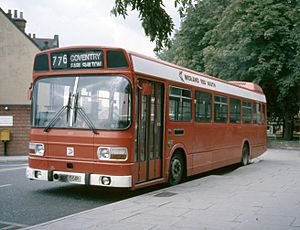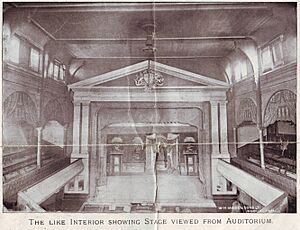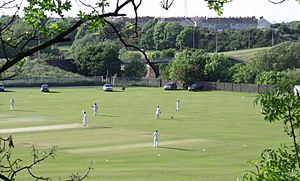Workington facts for kids
Quick facts for kids Workington |
|
|---|---|
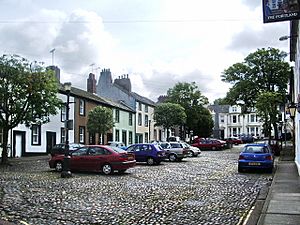 Portland Square, 2007 |
|
| Population | 25,207 (2011) |
| OS grid reference | NX996279 |
| • London | 259 mi (417 km) SE |
| Civil parish |
|
| Unitary authority |
|
| Ceremonial county | |
| Region | |
| Country | England |
| Sovereign state | United Kingdom |
| Post town | WORKINGTON |
| Postcode district | CA14 |
| Dialling code | 01900 01946 |
| Police | Cumbria |
| Fire | Cumbria |
| Ambulance | North West |
| EU Parliament | North West England |
| UK Parliament |
|
Workington is a town on the coast of Cumbria, England. It sits where the River Derwent meets the sea. In 2011, about 25,207 people lived here. Workington has a long history, especially with coal and steel. Today, it's a lively place with interesting traditions and sports.
Contents
Where is Workington?
Workington is located in the north-west of England. It is about 32 miles (51 km) south-west of Carlisle. The town is also 8 miles (13 km) north-east of Whitehaven. You can find it 7 miles (11 km) west of Cockermouth. It's also 5 miles (8 km) south-west of Maryport.
A Look Back: Workington's History
The area around Workington has always been important for coal and steel. Long ago, between 79 and 122 CE, the Romans built forts and watchtowers. These were along the Cumbrian coast to protect against attacks. A Viking sword found at Northside suggests Vikings also settled here.
The name Workington first appeared in 946. It was called Wurcingtun, meaning "the town of Weorc or Wirc's people." In 2009, the River Derwent caused floods. Several bridges in the town were damaged or destroyed.
Making Workington Better
In 2006, a new shopping center called Washington Square opened. It cost £50 million and replaced an older, worn-out area. In 2007, it was named the "best commercial project" in North West England.
The town center also has cool public art pieces. These include glass canopies and a sculpture called The Coastline. There's also The Hub and special metalwork at the car park. The public toilets even have unique tiles and a fish tank. An interactive town clock, called the Lookout Clock, was also added.
Future Plans for Workington
A plan to build a large Tesco store caused some debate. Many local people did not want it built on the Cloffocks land. They said this land was common ground for everyone in Workington. After much discussion, the council decided not to sell the land to Tesco in 2011.
How Workington is Governed
Workington is part of the parliamentary area called Whitehaven and Workington. In the 2024 election, Josh MacAlister from the Labour Party became the MP.
Historically, Workington has mostly supported the Labour Party. It has only elected a Conservative MP twice since World War II.
For local matters, Workington is managed by Cumberland. Workington also has its own local council, called Workington Town Council. The current mayor for 2024–2025 is Neil Schofield.
Workington's Location and Areas
Workington is located on the River Derwent. It is on the flat coastal land of West Cumbria. To the west is the Solway Firth, which is part of the Irish Sea. To the east are the beautiful Lake District fells.
The town has many different areas, often built as housing estates. North of the river are places like Seaton and Northside. South of the river are areas such as Stainburn, Mossbay, and Salterbeck. A large working-class area called The Marsh and Quay was taken down in the 1980s. Now, an industrial estate covers much of that land.
Workington's Economy
Iron and Steel History
Workington was once a major center for iron and steel. The area had special iron ore that was perfect for making steel. In the 1800s, Sir Henry Bessemer invented a new way to make steel quickly. This led to the world's first large-scale steelworks opening in Workington. The Bessemer process was used here until 1974. The main steelworks closed in 1982.
During World War II, an important electric steel furnace was moved to Workington from Norway. This was done to keep it safe from enemy hands.
Workington was also home to Distington Engineering Company (DEC). This company designed equipment for making steel. Today, this business is owned by the TATA Group and employs 400 people.
One important product was railway rails. Workington rails were sent all over the world! People used to say Workington rails "held the world together." The rail plant closed in 2006.
After Coal and Steel
After the coal and steel industries closed, many people in Workington lost their jobs. Today, the town has new industries. These include chemicals, cardboard, and managing waste. The docks, which were first built by the steel company, are still used. There's also a company that recycles old computers.
Workington is home to the British Cattle Movement Service. This government group helps manage the British beef and dairy industry. Many people from Workington also work in the nuclear industry near Sellafield.
Vehicle Manufacturing
In the 1970s, British Leyland opened a factory in Lillyhall, near Workington. They built the Leyland National bus there. This bus was designed by an Italian designer, Giovanni Michelotti. The factory later built other types of buses too.
In the 1980s, Leyland also made Pacer and Sprinter trains in Workington. The Pacer trains used parts of the bus design to make them cheaper.
In 1988, Volvo Buses bought Leyland Buses. The factory closed in 1993, and 200 jobs were lost. The old bus factory is now a warehouse for a company called Eddie Stobart.
Getting Around Workington
Workington is connected by the A596 road to Maryport and by the A595 road to Whitehaven. The A66 road goes to Penrith and beyond. The town has its own bus station. Buses connect Workington to other towns and villages in Cumbria.
The Cumbrian Coast line offers train services from Workington railway station to Carlisle and Barrow-in-Furness. Sometimes, trains go all the way to Lancaster and Preston.
Workington North railway station opened in 2009. It was a temporary station to help people cross the river after floods closed road bridges. A free train service ran between Workington and Maryport for a while.
The Workington Transport Heritage Trust works to save the history of transport in the area. It is run by volunteers.
Arts and Entertainment in Workington
Workington has three theaters: the Carnegie Theatre, Theatre Royal, and Workington Opera House. In the past, many famous performers, like Tommy Cooper and Shirley Bassey, came to Workington. The Workington Opera House even hosted circus shows with animals!
The Carnegie Theatre and Theatre Royal are still open today. They have shows all year long. The Workington Opera House is currently closed, but a group called "Opera Action" hopes to restore it.
The town used to have four cinemas, but they are all closed now. The only cinema left is the Parkway Cinema at Dunmail Park.
Fun Festivals
In 2009, a charity music festival called Valentine Rock took place. It had 19 bands and raised money for the RNLI and West Cumberland Lions.
In 2008, the Paint Your Town Red Festival was held. It was called "The biggest free festival in Workington's history." It included a free fun fair for children and lots of stage entertainment.
News and Radio
Local news and TV shows for Workington come from BBC North East and Cumbria and ITV Border.
You can listen to local radio stations like BBC Radio Cumbria on 95.6 FM. There's also Greatest Hits Radio Cumbria & South West Scotland on 102.2 FM. Workington Academy Radio is a student-run station that broadcasts to the Workington Academy.
The local newspaper for the town is the Times & Star.
Sports in Workington
Uppies and Downies
Workington is famous for a traditional game called Uppies and Downies. It's a bit like a very old form of football. Since 2001, these games have raised over £75,000 for local charities. The special ball for Uppies and Downies is made from cow leather. It's about 21 inches (53 cm) around and weighs about 2.5 pounds (1.1 kg). Only three of these handmade balls are made each year.
Football
The town has a football team called Workington A.F.C.. They play at Borough Park. The team used to be professional but now plays as a non-League club. The original team was formed in 1888 by steel workers. Famous manager Bill Shankly was one of their first coaches.
Rugby League
Workington also has a semi-professional rugby league team, Workington Town. They play at Derwent Park Fibrus Community Stadium.
Rugby Union
The town is home to the rugby union team Workington Zebras. They play their matches at the Ellis Sports Ground.
Bowling
There are two bowling greens in Workington. One is in Vulcan Park, and the other is on High Cloffocks. Teams and players from these greens compete in many competitions.
Golf
Workington's first golf club started in 1893. The current Workington Golf Club is at Hunday Wood. It's considered "one of the best courses in Cumbria."
Speedway
Workington Comets are the town's professional speedway team. They race in the British Speedway Premier League. Speedway racing returned to Workington in 1970. In 2008, the team won several championships.
Cricket
Workington Cricket Club plays at the Ernest Valentine Ground. It's a busy club with three senior teams and many junior teams. They are part of the Cumbria Cricket League.
Angling
The Workington and District Sea Angling Club holds regular fishing matches. They also teach people how to fish. Freshwater anglers enjoy fishing in local rivers, especially the River Derwent.
Athletics
Workington offers many athletic activities. These include track and field, triathlon, road running, cross-country, and fell running. Local schools and clubs are part of the Cumbria Athletics Association. Workington athletes have won honors in the English Schools Athletic Association Championships.
Motorbike Road Riding
The West Cumbrian motorcycle club, the Roadburners, started in 1989. They often take part in local and national motorbike events and charity rides.
Famous People from Workington
Workington's Twin Towns
Workington is connected with two other towns around the world:
- Selm, Germany
- Val-de-Reuil, France
See also
 In Spanish: Workington para niños
In Spanish: Workington para niños


